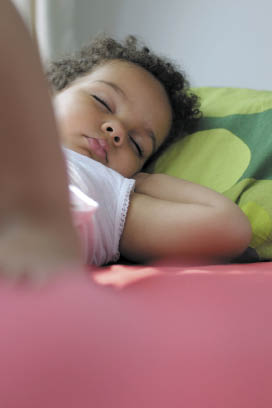
Sleep Like a Baby
Tackling the sleep problems that keep your
little one – and you – up at night
Story by Jamey Bradbury
Just when you think you are getting used to your baby’s sleep habits, his next phase of development begins – and, with it, a whole new set of sleeping challenges.
Gaining control over bedtime may seem like an impossibility, particularly when dealing with an infant whose sleep-wake cycle depends on feeding times. But it can be done – and the first step is knowing what to expect.
All Through the Night
“Most of the problems reported by parents are related to sleep duration,” says Dr. Corneliu Antonescu, a pediatrician with the Tanana Valley Clinic in Fairbanks. It can be hard to pin down how, and when, an infant should be sleeping because most people have their own ideas about what’s “normal.”
As it turns out, there is some predictability to an infant’s sleep habits. According to Marcy Custer, maternal child health nurse consultant with the Alaska Department of Health and Social Services, “the total number of hours a baby sleeps in the first year doesn’t change much. What really changes is the amount of time the baby sleeps. As they get older, they can sleep for longer periods of time, and they’re awake for longer, too.”
From the moment she’s born until roughly the age of 1, a baby will sleep an average of 11 to 14 hours during a 24-hour day. But throughout that first year, the organization of sleep will change. While a newborn wakes every three to four hours (or two to three hours for breast-fed infants), she’ll gradually begin to sleep for longer periods. She will also start to sleep less during the day and more at the night. At 6 to 12 months, most babies can sleep eight to 10 hours at night, though there may still be occasional awakenings, especially if an infant is irritable or sick.
Understanding how sleep patterns change over that first year can be a big part of coping with sleep problems. “If parents have a concern,” says Marcy, “one good idea is to keep a diary and record when the baby is waking up. Some parents discover that it’s a pretty regular pattern.”
The Sun and Sleep
The extended daylight of an Alaskan summer affords Northerners more hours for fun in the sun, but it poses a unique problem for parents who are trying to help their children establish good sleeping habits. "It's particularly important to understand that the sleep-wake cycle is dependent on the exposure to light," says Dr. Corneliu Antonescu. "Exposure to bright lights during wakeful periods, and the peace and quiet of the restful periods, are important factors in regulating everybody's sleep." Not only can sunlight make it difficult to fall asleep, but it also influences a person's internal clock. When cells in the retina of the eye are exposed to light, they tell the brain that it's daytime, a process that helps set the sleep-wake cycle. "Consistency, in terms of going to bed and waking up at the same time every day, is important," says Dr. Antonescu. Marcy Custer suggests "setting the environment" to create a more inviting sleep atmosphere. Pull the curtains and dim the lights. If the Alaskan sun is too bright, consider using black-out curtains to help your child get ready for bedtime – or daytime naps. Experts also recommend not having a TV or other media devices in the bedroom.
‘Play is for Day’
Knowing what to expect is one thing; pacing the floor with a crying baby at 2 a.m. is another. So how can parents deal with frequent nighttime wakings?
“I hate to say ‘make it a boring visit,’ ” says Marcy, “but otherwise, the child will want to play and stay awake.” She advises parents to tend to the immediate need – whether it’s a wet diaper or a feeding – then leave the room.
“Sometimes,” she adds, “babies will stir and if you don’t go to them right away, they’re doing their own regulation and putting themselves back to sleep.” Parents can help newborns learn to self-regulate by allowing thumbsucking or pacifier-sucking when the baby is falling asleep.
Choosing the right time for putting an infant in bed is also crucial. At 1 to 2 months, a baby should be placed in his crib when he is asleep – that is, when he has no face or eye movement and is breathing regularly. “Around 3 months,” says Marcy, “putting the baby down when they’re drowsy helps them learn to put themselves to sleep.” By 6 to 12 months, most infants will have learned how to use self-soothing techniques to fall asleep. Middle-of-the-night wakings will still happen, especially with breast-fed babies, but mothers can help their infants get back to sleep by making feeding time less playful and keeping the lights low.
Keep It Predictable
Routines, according to Dr. Antonescu, can solve many of the going-to-bed problems parents encounter with their toddlers. “Developing some steps that kids take every night while getting ready for bed, reducing stimulation, activity level and noise, should all be helpful.”
The routine doesn’t have to be complicated. Begin by turning off the television well before bedtime. “Small children just don’t need it,” Marcy Custer says. “At that age, human interaction is much more valuable.” Food can act as a stimulant, so parents should avoid sugary snacks or drinks in the evening.
Use this time to teach your child to take care of her teeth by making tooth brushing part of the evening ritual. Once you’re in the bedroom, stick to quiet activities, like singing or telling stories. “Toddlers should be allowed and encouraged to take a favorite object, like a teddy bear, to bed,” says Dr. Antonescu. “They should sleep in their own bed, if possible in their own room.”
Don’t Be Afraid of the Dark
While a quiet routine can help make going to bed a comforting experience, it doesn’t necessarily mean that the rest of the night will be uneventful. Dr. Antonescu has fielded questions from his patients about everything from sleepwalking to night terrors, to the monster under the bed.
“Sleepwalking is not uncommon in children,” he says. “The best approach is to see that the environment is organized so there is no possibility of injury.” A neat floor, free of objects a sleepwalking child might trip over, and a safety gate at the top of stairs can prevent accidents. “During the sleepwalking episode, the child should be redirected to bed, without waking them fully.”
Nightmares are also common. “They’re different from sleep terrors in that you can reassure someone who wakes up from a nightmare,” says Dr. Antonescu. Sleep terrors, which are characterized by crying, screaming or kicking and thrashing, can be frightening for the parent, but usually won’t be remembered by the child the next morning. Occasional sleep terrors aren’t a cause for concern, though, as toddlers generally outgrow them. To prevent night terrors, Dr. Antonescu recommends “avoiding stressful and tiring days and avoiding going to bed with a full bladder if the toddler is potty-trained.”
As for the monster lurking in the closet? “Parents can use a small atomizer filled with colored water,” says Dr. Antonescu. “They can help their children spray the room for ‘monsters.’ ”
Occasionally, parents encounter problems that can’t be solved with a water spritzer. Frequent snoring, consistent night terrors and sleep apnea are all less common, but are the kinds of issues that should be brought to the family pediatrician’s attention. Marcy Custer encourages parents to talk openly with their pediatricians about any bedtime concerns. “Often, they’ll get reassurance that whatever the child is experiencing is typical.”










